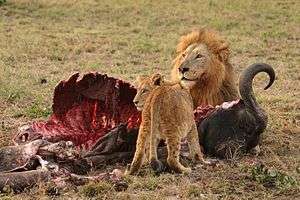Hypercarnivore

A hypercarnivore is an animal which has a diet that is more than 70% meat, with the balance consisting of non-animal foods such as fungi, fruits or other plant material.[1][2] Some examples include owls, shrikes, eagles, felids, dolphins, snakes, marlin, spiders, scorpions and most sharks. Every species in the Felidae family, including the domesticated cat, is a hypercarnivore in its natural state. Some well-known hypercarnivorous invertebrates are octopuses and starfish. Additionally, this term is also used in paleobiology to describe taxa of animals which have an increased slicing component of their dentition relative to the grinding component.[2] Hypercarnivores need not be apex predators. For example, salmon are exclusively carnivorous, yet they are prey at all stages of life for a variety of organisms.
Many prehistoric mammals of the clade Carnivoramorpha (Carnivora and Miacoidea without Creodonta), along with the early order Creodonta, and some mammals of the even earlier order Cimolesta, were hypercarnivores. The earliest carnivorous mammal is considered to be Cimolestes, which existed during the Late Cretaceous and early Paleogene periods in North America about 66 million years ago. Theropod dinosaurs such as Tyrannosaurus rex that existed during the late Cretaceous, although not mammals, were obligate carnivores.
Large hypercarnivores evolved frequently in the fossil record, often in response to an ecological opportunity afforded by the decline or extinction of previously dominant hypercarnivorous taxa. While the evolution of large size and carnivory may be favored at the individual level, it can lead to a macroevolutionary decline, wherein such extreme dietary specialization results in reduced population densities and a greater vulnerability for extinction.[3] As a result of these opposing forces, the fossil record of carnivores is dominated by successive clades of hypercarnivores that diversify and decline, only to be replaced by new hypercarnivorous clades.
As an example of related species with differing diets, even though they diverged only 150,000 years ago,[4] the polar bear is the most highly carnivorous bear (more than 90% of its diet is meat) while the grizzly bear is one of the least carnivorous in many locales, with less than 10% of its diet being meat.[5][6][7]
See also
References
| Look up hypercarnivore in Wiktionary, the free dictionary. |
- ↑ Van Valkenburgh, B. (1988). "Trophic diversity in past and present guilds of large predatory mammals". Paleobiology. 14: 155–73.
- 1 2 Holliday, J.A; Steppan, S.J. (2004). "Evolution of hypercarnivory: the effect of specialization on morphological and taxonomic diversity". Paleobiology. 30 (1): 108–128. doi:10.1666/0094-8373(2004)030<0108:EOHTEO>2.0.CO;2. ISSN 0094-8373.
- ↑ Van Valkenburgh, B.; Wang, X; Damuth, J (2004). "Cope's Rule, Hypercarnivory, and Extinction in North American Canids". Science. 306 (5693): 101–4. Bibcode:2004Sci...306..101V. doi:10.1126/science.1102417. PMID 15459388.
- ↑ Lindqvist, Charlotte; Schuster, Stephan C.; Sun, Yazhou; Talbot, Sandra L.; Qi, Ji; Ratan, Aakrosh; Tomsho, Lynn P.; Kasson, Lindsay; et al. (2010). "Complete mitochondrial genome of a Pleistocene jawbone unveils the origin of polar bear". PNAS. 107 (11): 5053–5057. Bibcode:2010PNAS..107.5053L. doi:10.1073/pnas.0914266107. PMC 2841953
 . PMID 20194737.
. PMID 20194737. - ↑ Stephen Herrero (1985). Bear Attacks, their causes and avoidance. p. 156.
- ↑ "Arctic Bears". PBS Nature. 17 February 2008.
- ↑ "Grizzly". Hinterland Who's Who. Retrieved March 4, 2010{{inconsistent citations}}
